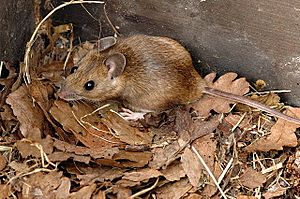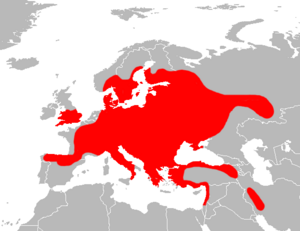Yellow-necked mouse facts for kids
Quick facts for kids Yellow-necked mouse |
|
|---|---|
 |
|
| Conservation status | |
| Scientific classification | |
| Genus: |
Apodemus
|
| Species: |
flavicollis
|
 |
|
| Synonyms | |
|
|
The yellow-necked mouse (Apodemus flavicollis) is a small rodent that looks a lot like the wood mouse. For a long time, people thought they were the same animal! But in 1894, scientists realized they were different species. You can tell a yellow-necked mouse apart by the bright yellow fur around its neck. It also has slightly bigger ears and is usually a bit larger overall. These mice are about 100 mm (4 inches) long. They are great at climbing trees and sometimes even spend the winter inside houses. You can find them mostly in mountain areas of southern Europe. They also live further north in parts of Scandinavia and Britain.
Contents
What Does a Yellow-Necked Mouse Look Like?
The yellow-necked mouse looks very similar to the wood mouse. However, it has a slightly longer tail and bigger ears. It also has a clear band of yellow fur across its neck. An adult mouse's head and body are about 3.5 to 5.25 inches long. Its tail is usually about the same length. These mice weigh between 1 and 1.5 ounces.
Their upper fur is brownish-grey, which is a bit browner than the wood mouse. Their belly fur is white. There is a clear line where the brown and white colors meet. The yellow patch of fur on their neck gives them their name. Young mice have lighter, greyish-brown fur than adults.
Where Do Yellow-Necked Mice Live?
The yellow-necked mouse is native to Europe and western Asia. You can find them in the mountainous parts of Western Europe. They are not found in northern Scandinavia, southern Spain, or western France. These mice live in Great Britain but not in Ireland. They are also missing from some islands in the Mediterranean Sea.
In Asia, their home range goes east to the Ural Mountains. They also live in Turkey, Armenia, Iran, Syria, Lebanon, and Israel. They mostly prefer woodlands, often living near the edge of forests. In mountains, they can live anywhere in the forest. They like old deciduous woodlands, but also scrubby areas, hedgerows, orchards, and tree farms. They especially like places with large, nut-bearing trees like oak and hazel. You might also see them in parks, gardens, and near streams lined with alder trees.
Yellow-Necked Mouse Behaviour
Yellow-necked mice are active all year round and do not hibernate. Sometimes, several mice will huddle together in winter to stay warm. They are excellent climbers and move easily through trees and bushes. They live in cracks, burrows at the base of trees, holes in tree trunks, hollow logs, and even bird nesting boxes. Sometimes, they enter human buildings.
Their burrows can be very large with many entrances and complex tunnels. They store lots of food, like acorns and beechmast, in special storage rooms. They use other rooms for nesting, bringing in dry plants to make cozy beds. You can often see small mounds of earth outside their burrow entrances. They also hide food in holes in trees away from their main burrow.
These mice are nocturnal, meaning they are active at night. They move around on the ground and in the tree branches. Their home range is usually smaller than half a hectare. Besides nuts, they eat buds, shoots, fruit, young plants, and sometimes small insects.
Reproduction and Life Cycle
Yellow-necked mice can have babies at any time between February and October. Females can get pregnant again shortly after giving birth. Pregnancy lasts about 26 days. Females can even get pregnant again while still feeding their last litter of babies.
A litter of young is born in a nesting room lined with dry plant material. A litter usually has five babies, but it can be anywhere from two to eleven. The babies are born naked, blind, and helpless. Their eyes open after about two weeks. By then, their yellow collars start to show as grey patches. They stop drinking milk from their mother at about 18 days old. If they are born early in the year, they might start having their own babies in the same year. However, babies born later in the year become adults and can reproduce the following spring.
Who Hunts the Yellow-Necked Mouse?
Owls, foxes, weasels, and other predators hunt yellow-necked mice. These mice can jump to escape attackers. The skin on their tail can easily come off if a predator grabs it. This helps them get away!
Research and Health
Scientists have found that the yellow-necked mouse can carry a virus that causes tick-borne encephalitis. This virus can make people sick, but the mouse itself is not affected by it. Research has also shown that the yellow-necked mouse, along with the striped field mouse, carries the Dobrava virus. This virus can cause a serious illness in humans called haemorrhagic fever with renal syndrome.
Status in the Wild
The yellow-necked mouse lives in a very large area and is common where it lives. In Eastern Europe, there can be as many as one hundred mice in an area the size of a football field. Their population is stable, meaning it's not going up or down much. This species does not face any major threats. Because of this, the IUCN (International Union for Conservation of Nature) has listed it as being of "Least Concern" on its Red List of Threatened Species. This means they are not currently at risk of disappearing.
Images for kids




